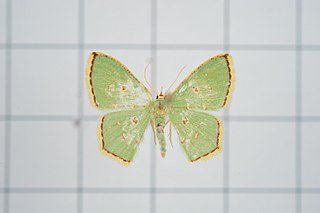Related Research Articles

Moths are a paraphyletic group of insects that includes all members of the order Lepidoptera that are not butterflies, with moths making up the vast majority of the order. There are thought to be approximately 160,000 species of moth, many of which have yet to be described. Most species of moth are nocturnal, but there are also crepuscular and diurnal species.

The Gelechiidae are a family of moths commonly referred to as twirler moths or gelechiid moths. They are the namesake family of the huge and little-studied superfamily Gelechioidea, and the family's taxonomy has been subject to considerable dispute. These are generally very small moths with narrow, fringed wings. The larvae of most species feed internally on various parts of their host plants, sometimes causing galls. Douglas-fir (Pseudotsuga) is a host plant common to many species of the family, particularly of the genus Chionodes, which as a result is more diverse in North America than usual for Gelechioidea.

Pyrrharctia isabella, the isabella tiger moth, banded woolly bear or just woollybear or woolly worm, occurs in the United States and southern Canada. It was first formally named by James Edward Smith in 1797.

The western barbastelle, also known as the barbastelle or barbastelle bat, is a European bat in the genus Barbastella. This species is found from Portugal to Azerbaijan and from Sweden to Canary Islands, where a sub-species was identified. It has a short nose, small eyes and wide ears. The conservation status of B. barbastellus is assessed as "Near Threatened", "Vulnerable", "Critically Endangered" or "Extinct" in various parts of its range.

The Adelidae or fairy longhorn moths are a family of monotrysian moths in the lepidopteran infraorder Heteroneura. The family was first described by Charles Théophile Bruand d'Uzelle in 1851. Most species have at least partially metallic patterns coloration and are diurnal, sometimes swarming around the tips of branches with an undulating flight. Others are crepuscular and have a drab coloration. Fairy longhorn moths have a wingspan of 4–28 millimeters, and males often have especially long antennae, 1–3 times as long as the forewing.

Schinia, commonly called flower moths, is a large genus of moths belonging to the family Noctuidae. The genus has a Holarctic distribution with the vast majority of species being found in North America, many with a very restricted range and larval food plant.

The 2018 Summer Youth Olympics, officially known as the III Summer Youth Olympic Games, and commonly known as Buenos Aires 2018, were an international sports, cultural, and educational event held in Buenos Aires, Argentina between 6 and 18 October 2018. They were the first Summer Youth Olympic Games held outside of Asia, and the first Youth Games for either summer or winter held outside Eurasia. It was the second Olympic Games held in South America after the 2016 Summer Olympics in Rio de Janeiro, Brazil.

Symmacra is a monotypic moth genus in the family Geometridae described by Warren in 1896. Its only species, Symmacra solidaria, was first described by Achille Guenée in 1858. It is found in Indo-Australian tropics of India, Sri Lanka, Borneo east to Fiji, Samoa and Australia.

Amblyptilia pica, the geranium plume moth, is a moth of the family Pterophoridae. The species was first described by Baron Walsingham in 1880. It is found in western North America from Alaska to California, inland to Alberta and Kansas. It is also found in the north-eastern United States and Ontario.
Like Moths to Flames is an American metalcore band from Columbus, Ohio, formed in 2010 by former members of various bands, including Emarosa, Agraceful, the Crimson Armada, and My Ticket Home. The band has released four studio albums and three EPs through Rise Records. The band's current line-up consists of lead vocalist Chris Roetter, bassist Aaron Evans, lead guitarist Jeremy Smith, and rhythm guitarist Zach Pishney. Roetter and Evans are the only two members of the original line-up that remain in the band.
Tinerastia discipunctella is a moth of the family Pyralidae.

Bamra albicola is a moth of the family Noctuidae first described by Francis Walker in 1858.
Brana is a monotypic moth genus of the family Noctuidae. Its only species, Brana calopasa, is found in Sri Lanka and Australia. Both the genus and species were described by Francis Walker, the genus in 1858 and the species in 1859. It It is a serious pest on Berrya cordifolia.

Caduca albopunctata is a moth of the family Noctuidae first described by Francis Walker in 1857.
Calesia haemorrhoa, the gray-winged gibbon moth, is a moth of the family Noctuidae. It was first described by Achille Guenée in 1852. It is found in India and Sri Lanka. The forewings are a uniform grayish color. The head, femora, tibiae and abdomen are fringed with pinkish-orange hairs. Caterpillars are known to feed on Justicia wynaadensis, Justicia vasica, Barleria cristata and Eranthemum nervosum.
Hyperlopha cristifera is a moth of the family Noctuidae first described by Francis Walker in 1863. It is found in Sri Lanka, Laos, Malaysia and Australia. Adult wings are pale brown, sometimes with a number of dark dots near the tornus of each forewing. Forewings with a hooked wingtip, and a cusp on the margin can be found.

Olulis puncticinctalis is a moth of the family Noctuidae first described by Francis Walker in 1863. It is found in Borneo, Peninsular Malaysia, the Andaman Islands, India, Sri Lanka, Taiwan and Japan.
Radara subcupralis is a moth of the family Noctuidae first described by Francis Walker in 1866.

Comostola subtiliaria is a moth of the family Geometridae first described by Otto Vasilievich Bremer in 1864. It is a widespread species which is found in Korea and adjacent parts of Siberia, Japan, Borneo, Sumatra, India, South China, Taiwan, Borneo, Sumatra, and Sri Lanka.
References
- ↑ "Butterflies and Moths of the World - Genus details". The Natural History Museum. Retrieved 2 March 2018.
- ↑ "Species Details : Tinerastia fissirella Hampson, 1896". Catalogue of Life. Retrieved 2 March 2018.